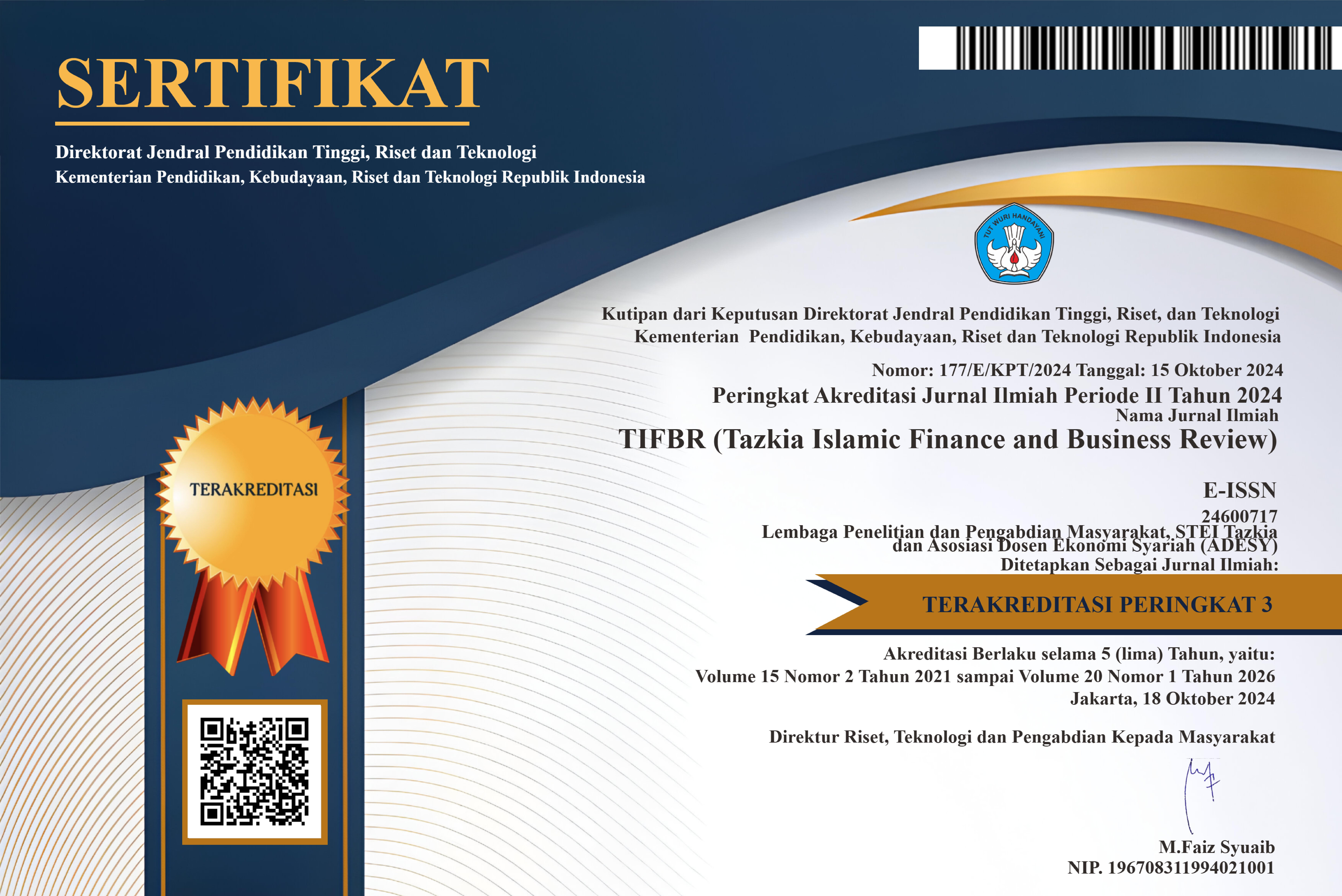Does Dual Banking System in Indonesia Differentiate Investment Account Requirement?
DOI:
https://doi.org/10.30993/tifbr.v11i1.132Keywords:
Islamic Banking, Investment Account, Irregular DepositAbstract
Abstract. This paper aims to propose a model of investment account based on Islamic Financial Services Board guiding principles. The research figures out some factors affecting the process of deploying investment account, the proposed model, cost - benefit analysis as well as the steps to be taken by Islamic banking stakeholders to install the model in the future. Having reviewed many litetatures related to irregular deposit, investment account as well as the institutional theory, the study found that the adoption of investment account heavily relies on the political factor applied by Bank Indonesia. Law No. 21 Year 2008 that regulates Indonesian Islamic Banking clause 35 stated that Bank Indonesia has coercive power to drive the accounting and governance standard for the Indonesian Islamic banking. Other actors such as Financial Services Authority, National Sharia Board, and Indonesia Deposit Insurance Corporation also do affect the regulation on Investment Account. This paper informs the policy makers to set different regulation on investment account within the practice of dual banking system.
References
Ameer, R., Othman, R. and Mahzan, N. (2012). Information Asymmetry and Regulatory Shortcomings in Profit Sharing Investment Accounts. International Journal of Islamic and Middle Eastern Finance and Management, Vol. 5(4): 371–387.
Anshori, A.G. (2008). Sejarah Perkembangan Hukum Perbankan Syariah di Indonesia dan Implikasinya Bagi Praktik Perbankan Nasional. La_Riba Jurnal Ekonomi Islam, Vol. II(2): 159–172.
Anuar, K., Mohamad, S. and Eskandar, S.M. (2014). Are Deposit and Investment Accounts in Islamic Banks in Malaysia Interest Free ? JKAU : Islamic Econ, Vol. 27(2): 27–55.
Archer, S. and Karim, R.A.A.A. (2009). Profit-Sharing Investment Accounts in Islamic Banks : Regulatory Problems and Possible Solutions. Journal of Banking Regulation, Vol. 10(4): 300–306.
Archer, S. and Karim, R.A.A.K. (2012). The Structure, Regulation and Supervision of Islamic Banks. Journal of Banking Regulation, Vol. 13(3): 228–240. Available at: http://dx.doi.org/10.1057/jbr.2012.3.
Ascarya and Yumanita, D. (2005). Bank Syariah : Gambaran Umum. Jakarta.
Bagus, P., Gabriel, A. and Howden, D. (2016). Reassessing the Ethicality of Some Common Financial Practices. Journal of Business Ethics, Vol. 134: 471–480. Available at: http://dx.doi.org/10.1007/s10551-014-2525-9.
Bagus, P. and Howden, D. (2010). Fractional Reserve Free Banking: Some Quibbles. The Quarterly Journal of Austrian Economics, Vol. 13(4): 29–56.
Bagus, P. and Howden, D. (2012). The Continuing Continuum Problem of Deposits and Loans. Journal of Business Case Studies - Spanish Edition, Vol. 106: 295–300.
Bagus, P. and Howden, D. (2016). The Economic and Legal Significance of “full” Deposit Availability. European Journal of Law and Economics, Vol. 243–254. Available at: http://dx.doi.org/10.1007/s10657-012-9347-y.
Bagus, P. and Howden, D. (2009). The Legitimacy of Loan Maturity Mismatching: A Risky, but not Fraudulent, Undertaking. Journal of Business Ethics, Vol. 90(3): 399–406.
Bagus, P. and Howden, D. (2011). Unanswered Quibbles With Fractional Reserve Free Banking. Libertian Papers, Vol. 3(18): 1–24.
Bagus, P., Howden, D. and Gabriel, A. (2015). Oil and Water do not Mix , or: Aliud Est Credere , Aliud Deponere. Journal of Business Ethics, Vol. 128: 197–206.
Bank Indonesia. (2012). Peraturan BI No. 14/14/PBI/2012 Tentang Transparansi dan Publikasi Laporan Keuangan Bank. Jakarta.
Barnett II, W. and Block, W.E. (2009). Time Deposits , Dimensions , and Fraud. Journal of Business Ethics, Vol. 88: 711–716.
Cochran, J.P. and Call, S.T. (1998). The Role of Fractional-Reserve Banking and Financial Intermediation in The Money Supply Process: Keynes and The Asutrians. The Quarterly Journal of Austrian Economics, Vol. 1(3): 29–40.
De Soto, J.H. (1995a). A Critical Analysis of Central Banks and Fractional - Reserve Free Banking from The Austrian School Perspective. The Quarterly Journal of Austrian Economics, Vol. 8(2): 25–38.
De Soto, J.H. (1995b). Critical Analysis of Central Banks. The Review of Austrian Economics, Vol. 2(2) 25–38.
De Soto, J.H. (1998). A Critical Note on Fractional - Reserve Free Banking. The Quarterly Journal of Austrian Economics, Vol. 1(4): 25–49.
De Soto, J.H. (2006). Money, Bank Credit, and Economic Cycles. English Edition. M. A. Stroup, ed. Ludwig Von Mises Institute. Alabama.
DiMaggio, P.J. and Powell, W.W. (1983). The Iron Cage Revitised: Instituional Isomorphism and Collective in Organizational Fields. American Sociologigal Review, Vol. 48(2): 147–168.
Ebrahim, M.S. (2008). The Financial Crisis : Comments from Islamic. IIUM Journal of Economics and Management, Vol. 16(2): 111–138.
Ekanayake, A. and Perera, S. (2014). The Role of Accounting in Corporate Governance in A Developing Country : Institutional Political Economy Perspective Athula Ekanayake Sujatha Perera*. Journal Accounting, Auditing, Performance Evaluation, Vol. 10(2): 109–132.
Farooq, M.O. (2011). Qard Hasan, Wadiah/Amanah and Bank Deposits: Applications and Misapplications of Some Concepts in Islamic Banking. Arab Law Quarterly, Vol. 25(2): 115–146. Available at: http://dx.doi.org/10.1163/157302511X553985.
García, V.F., Cibils, V.F. and Maino, R. (2004). Remedy For Banking Crises: What Chichago and Islam Have in Common. Islamic Economic Studies, Vol. 11(2): 1–22.
Gilani, H. (2015). Exploring The Ethical Aspects of Islamic Banking. International Journal of Islamic and Middle Eastern Finance Management, Vol. 8(1): 85–98.
Hamza, H. and Saadaoui, Z. (2013). Investment Deposits, Risk-Taking and Capital Decisions in Islamic Banks. Studies in Economics and Finance, Vol. 30(3): 244–265.
Hanif, M. (2011). Differences and Similarities in Islamic and Conventional Banking. International Journal of Business and Social Science, Vol. 2(2): 166–175.
Hasan, Z. (2011). Money Creation and Control from Islamic Perspective. Munich.
Hasan, Z. (2014). The Basel Accords, Financial Turmoil, and Islamic Banks. ISRA International Journal of Islamic Finance, Vol. 6(2): 21–48.
Hulsmann, J.G. (2003). Banking Really Passed The. The Independent Review, Vol. VII(3): 399–422.
Hulsmann, J.G. (2004). Legal Tender Laws and Fractional - Reserve Banking. Journal of Libertian Studies, Vol. 18(3): 33–55.
IFSB (2007). Disclosures to Promote Transparency and Market Discipline for Institutions Offering Islamic Financial Services (Excluding Islamic Insurance (Takaful) Institutions and Islamic Mutual Funds): 1–42.
IFSB. (2005). Guiding Principles of Risk Management for Institutions (Other Than Insurance Institutions) Offering Only Islamic Financial Services.
IFSB. (2006). Guiding Principles on Corporate Governance for Institutions Offering only Islamic Financial Services (Excluding Islamic Insurance (Takaful) Institutions and Islamic Mutual Funds). Islamic Financial Service Board: 1–33.
IFSB. (2012). IFSB GP-12 Guiding Principles on Liquidity Risk Management.
Iqbal, Z. and Mirakhor, A. (2013). Economic Development and Islamic Finance. World Bank: Series on Directions in Development. Washington DC.
Ismal, R. (2014). An Optimal Risk – Return Portfolio of Islamic Banks. Humanomics, Vol. 30(4).
Ismal, R. (2010). Assessment of Liquidity Management in Islamic Banking Industry. International Journal of Islamic and Middle Eastern Finance and Management, Vol. 3(2): 147–167.
Ismal, R. (2011). Depositors’ Withdrawal Behavior in Islamic Banking: Case of Indonesia. Humanomics, Vol. 27(1): 61–76.
Ismal, R. (2008). Strengthening and Improving The Liquidity Management in Islamic Banking. Humanomics, Vol. 26(1): 18–35.
Javaid, O. (2015). Methodology of Institutional Analysis and its Implication for Contemporary Framework of Islamic Banks. Humanomics, Vol. 31(2): 183–200.
King, M. (2012). Creating Money Out of Nothing : The History of an Idea. 1–42.
Kunhibava, S. (2015). Legal Issues in Sharīʿah Governance in The Islamic. ISRA International Journal of Islamic Finance, Vol. 7(2): 55–80.
Lewis, M.K. (2007). Comparing Islamic and Christian Attitudes to Usury. in M. K. Hassan and M. K. Lewis, eds. The Handbook of Islamic Banking. Massachusetts. Edward Elgar Publishing Inc.
Mallett, J. (2015). General Disequilibrium : The Hidden Conflict between Fractional Reserve Banking and Economic Theory. Cosmos + Taxis, Vol. 2(2): 18–33.
Meeks, G. et al. (2009). Accounting Standards and The Economics of Standards. Accounting and Business Research, Vol. 39(3): 191–210.
Meera, A. and Larbani, M. (2009). Ownership Effects of Fractional Reserve Banking: An Islamic Perspective. Humanomics, Vol. 25(2): 1–25.
Michael, S. and Rozeff, M.S. (2010). Rothbard on Fractional Reserve Banking A Critique. The Independent Review, Vol. 14(4): 497–512.
Ministry of Law. (2008). Undang-Undang Republik Indonesia No. 21 Tahun 2008 Tentang Perbankan Syariah. Indonesia.
Mukhlisin, M., Hudaib, M. and Azid, T. (2015). The Need for Shariah Harmonization in Financial Reporting Standardization The Case of Indonesia. International Journal of Islamic and Middle Eastern Finance and Management, Vol. 8(4): 455–471.
Nair, M. (2013). Fractional Reserves and Demand Deposits: Historical Evidence from An Unregulated Banking System. The Independent Review, Vol. 18(1): 77–88.
Nasution, A. (2000). The Meltdown of The Indonesian Economy: Causes, Responses and Lessons. Asean Economic Bulletin. Vol. 17(2): 148.
Ochaita, A.V. (2010). The Use of The Money In The Deposits Banking. Some Questions of Roman Law within The Framework of The Present Financial Crisis. Journal of Business Case Studies, Spanish Edition, Vol. 6(7): 37–43.
OJK. (2015). Peraturan OJK No. 6/POJK.03/2015 tentang Transparansi dan Publikasi Laporan Keuangan Bank. Indonesia.
Quinn, S. (1997). Goldsmith-Banking: Mutual Acceptance and Interbanker Clearing in Restoration London. Explorations In Economics History, Vol. 34: 411–432.
Radelet, S. and Sachs, J. (2000). The Onset of The East Asean Financial Crisis. In P. Krugman, ed. Currency Crises. Chicago. University Chicago Press: 105–103.
Rosman, R. et al. (2015). Accounting Issues in The Reporting of Profit Sharing Investment Accounts in Islamic Banks’ Financial Statements under IFSA 2013. ISRA International Journal of Islamic Finance, Vol. 7(1): 129–138.
Sahroni, O. and Karim, A.A. (2015). Maqasid Bisnis dan Keuangan Syariah: Sintesis Fikih dan Ekonomi. Rajawali Pers. Jakarta.
Selgin, G. (2012). Those Dishonest Goldsmiths. Financial History Review, Vol. 19(3): 269–288.
Syamlan, Y.T. (2016). The Epistemological Perspective of Fractional Reserve Banking System 100% Reserve Banking System: Where Should Islamic Banks Stands? Tazkia Islamic Finance and Business Review, Vol. 10(2): 61–80.
Downloads
Published
How to Cite
Issue
Section
License

Tazkia Islamic Finance and Business Review (TIFBR) is licensed under a Creative Commons Attribution-NonCommercial 4.0 International License.
Authors who publish with this journal agree to the following terms:
- Authors retain copyright and grant the journal right of first publication with the work simultaneously licensed under a Creative Commons Attribution License that allows others to share the work with an acknowledgment of the work's authorship and initial publication in this journal.
- Authors are able to enter into separate, additional contractual arrangements for the non-exclusive distribution of the journal's published version of the work (e.g., post it to an institutional repository or publish it in a book), with an acknowledgment of its initial publication in this journal.
- Authors are permitted and encouraged to post their work online (e.g., in institutional repositories or on their website), as it can lead to productive exchanges, as well as earlier and greater citation of published work (See the Effect of Open Access).
















